Organizational Behavior Report: M&S, Culture, Motivation, Success
VerifiedAdded on 2022/12/01
|6
|1386
|358
Report
AI Summary
This report provides an analysis of organizational behavior within Marks & Spencer. The report begins with an introduction to organizational behavior and its importance, followed by an examination of M&S's organizational culture using Handy's model, detailing power, task, person, and role cultures. It then explores how organizational culture improves organizational effectiveness with a focus on communication, evaluates the role of culture on employee motivation, and assesses how the company could use its culture to enhance its success. The report concludes with a summary of key findings and includes a list of references.
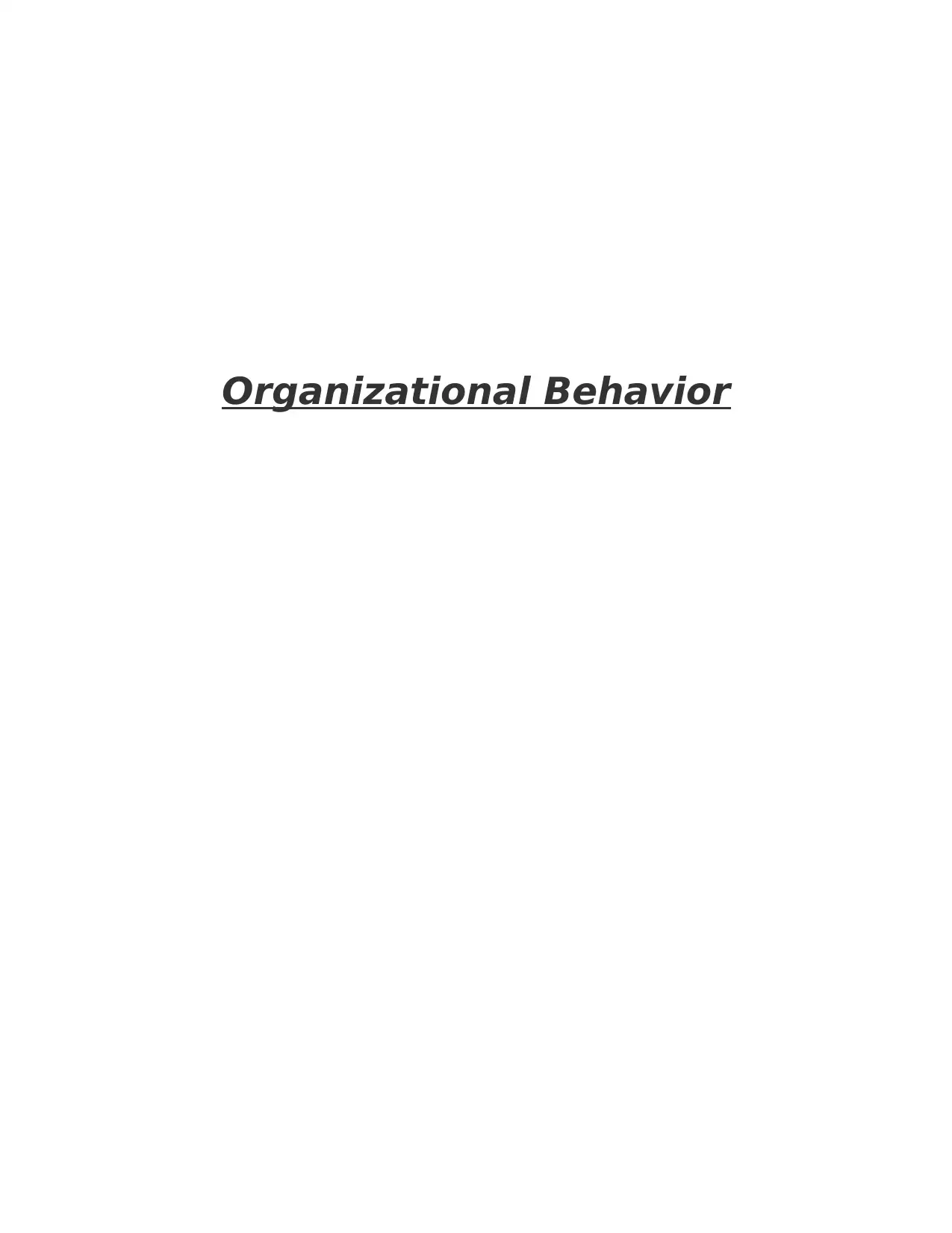
Organizational Behavior
Paraphrase This Document
Need a fresh take? Get an instant paraphrase of this document with our AI Paraphraser
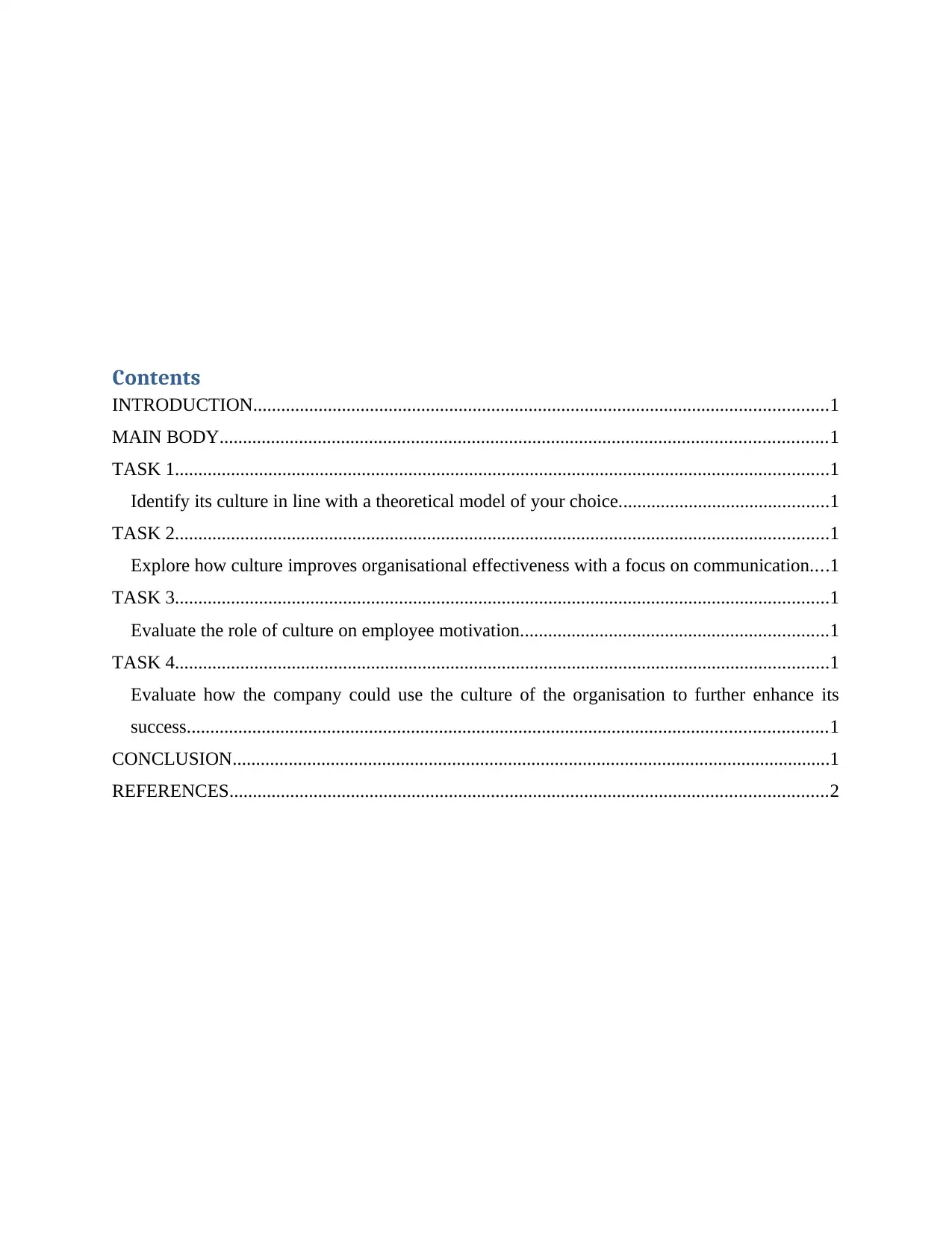
Contents
INTRODUCTION...........................................................................................................................1
MAIN BODY..................................................................................................................................1
TASK 1............................................................................................................................................1
Identify its culture in line with a theoretical model of your choice.............................................1
TASK 2............................................................................................................................................1
Explore how culture improves organisational effectiveness with a focus on communication....1
TASK 3............................................................................................................................................1
Evaluate the role of culture on employee motivation..................................................................1
TASK 4............................................................................................................................................1
Evaluate how the company could use the culture of the organisation to further enhance its
success.........................................................................................................................................1
CONCLUSION................................................................................................................................1
REFERENCES................................................................................................................................2
INTRODUCTION...........................................................................................................................1
MAIN BODY..................................................................................................................................1
TASK 1............................................................................................................................................1
Identify its culture in line with a theoretical model of your choice.............................................1
TASK 2............................................................................................................................................1
Explore how culture improves organisational effectiveness with a focus on communication....1
TASK 3............................................................................................................................................1
Evaluate the role of culture on employee motivation..................................................................1
TASK 4............................................................................................................................................1
Evaluate how the company could use the culture of the organisation to further enhance its
success.........................................................................................................................................1
CONCLUSION................................................................................................................................1
REFERENCES................................................................................................................................2
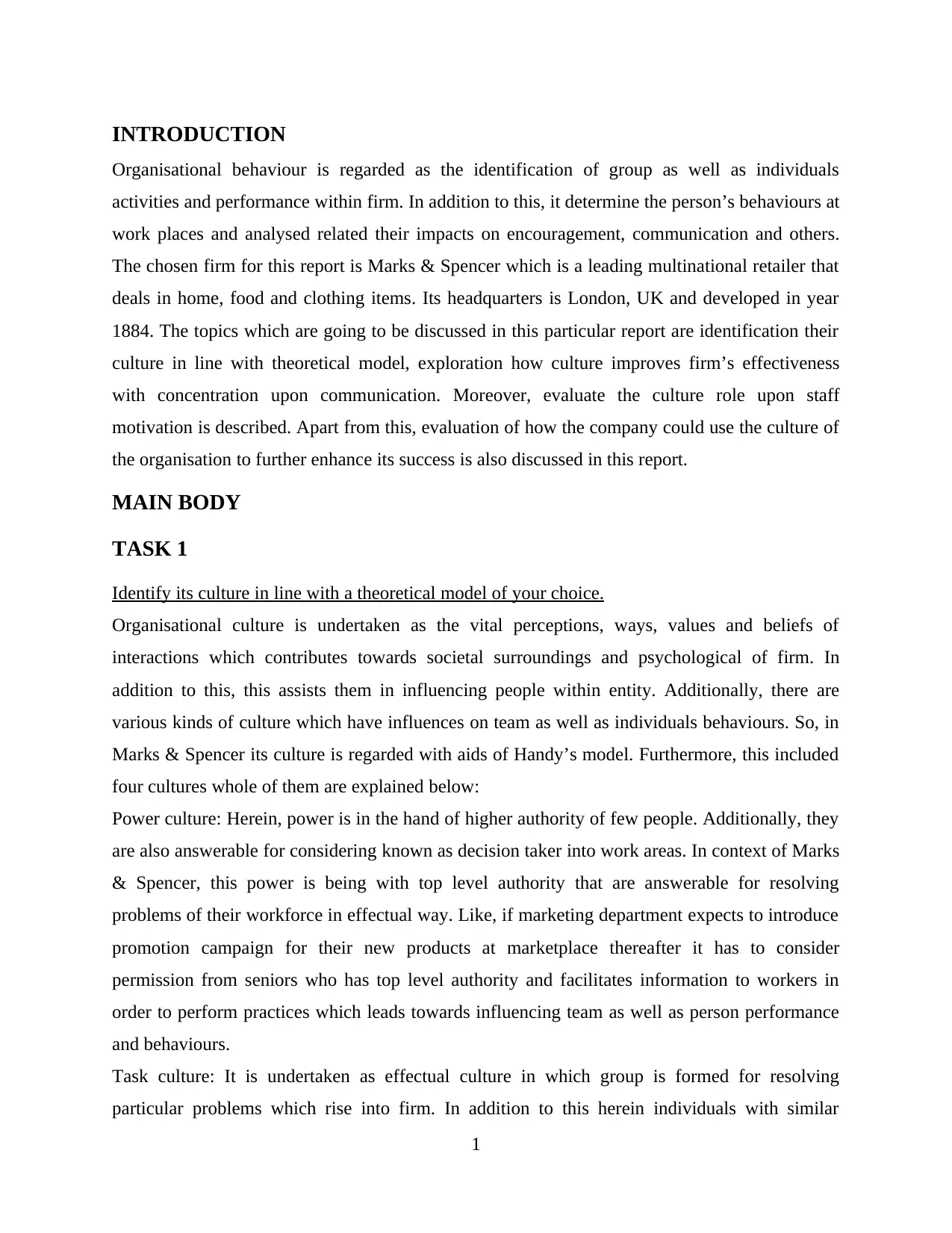
INTRODUCTION
Organisational behaviour is regarded as the identification of group as well as individuals
activities and performance within firm. In addition to this, it determine the person’s behaviours at
work places and analysed related their impacts on encouragement, communication and others.
The chosen firm for this report is Marks & Spencer which is a leading multinational retailer that
deals in home, food and clothing items. Its headquarters is London, UK and developed in year
1884. The topics which are going to be discussed in this particular report are identification their
culture in line with theoretical model, exploration how culture improves firm’s effectiveness
with concentration upon communication. Moreover, evaluate the culture role upon staff
motivation is described. Apart from this, evaluation of how the company could use the culture of
the organisation to further enhance its success is also discussed in this report.
MAIN BODY
TASK 1
Identify its culture in line with a theoretical model of your choice.
Organisational culture is undertaken as the vital perceptions, ways, values and beliefs of
interactions which contributes towards societal surroundings and psychological of firm. In
addition to this, this assists them in influencing people within entity. Additionally, there are
various kinds of culture which have influences on team as well as individuals behaviours. So, in
Marks & Spencer its culture is regarded with aids of Handy’s model. Furthermore, this included
four cultures whole of them are explained below:
Power culture: Herein, power is in the hand of higher authority of few people. Additionally, they
are also answerable for considering known as decision taker into work areas. In context of Marks
& Spencer, this power is being with top level authority that are answerable for resolving
problems of their workforce in effectual way. Like, if marketing department expects to introduce
promotion campaign for their new products at marketplace thereafter it has to consider
permission from seniors who has top level authority and facilitates information to workers in
order to perform practices which leads towards influencing team as well as person performance
and behaviours.
Task culture: It is undertaken as effectual culture in which group is formed for resolving
particular problems which rise into firm. In addition to this herein individuals with similar
1
Organisational behaviour is regarded as the identification of group as well as individuals
activities and performance within firm. In addition to this, it determine the person’s behaviours at
work places and analysed related their impacts on encouragement, communication and others.
The chosen firm for this report is Marks & Spencer which is a leading multinational retailer that
deals in home, food and clothing items. Its headquarters is London, UK and developed in year
1884. The topics which are going to be discussed in this particular report are identification their
culture in line with theoretical model, exploration how culture improves firm’s effectiveness
with concentration upon communication. Moreover, evaluate the culture role upon staff
motivation is described. Apart from this, evaluation of how the company could use the culture of
the organisation to further enhance its success is also discussed in this report.
MAIN BODY
TASK 1
Identify its culture in line with a theoretical model of your choice.
Organisational culture is undertaken as the vital perceptions, ways, values and beliefs of
interactions which contributes towards societal surroundings and psychological of firm. In
addition to this, this assists them in influencing people within entity. Additionally, there are
various kinds of culture which have influences on team as well as individuals behaviours. So, in
Marks & Spencer its culture is regarded with aids of Handy’s model. Furthermore, this included
four cultures whole of them are explained below:
Power culture: Herein, power is in the hand of higher authority of few people. Additionally, they
are also answerable for considering known as decision taker into work areas. In context of Marks
& Spencer, this power is being with top level authority that are answerable for resolving
problems of their workforce in effectual way. Like, if marketing department expects to introduce
promotion campaign for their new products at marketplace thereafter it has to consider
permission from seniors who has top level authority and facilitates information to workers in
order to perform practices which leads towards influencing team as well as person performance
and behaviours.
Task culture: It is undertaken as effectual culture in which group is formed for resolving
particular problems which rise into firm. In addition to this herein individuals with similar
1
⊘ This is a preview!⊘
Do you want full access?
Subscribe today to unlock all pages.

Trusted by 1+ million students worldwide
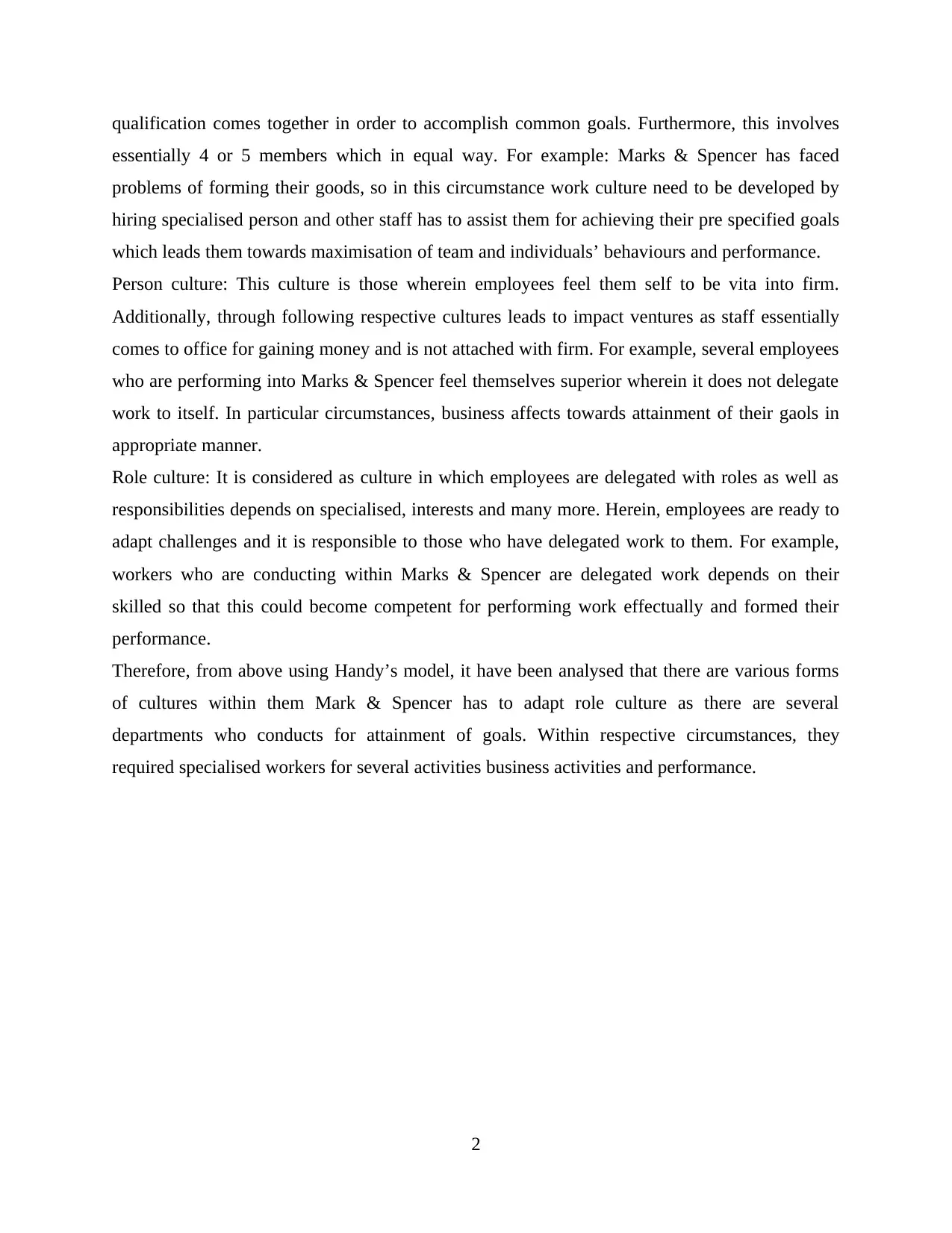
qualification comes together in order to accomplish common goals. Furthermore, this involves
essentially 4 or 5 members which in equal way. For example: Marks & Spencer has faced
problems of forming their goods, so in this circumstance work culture need to be developed by
hiring specialised person and other staff has to assist them for achieving their pre specified goals
which leads them towards maximisation of team and individuals’ behaviours and performance.
Person culture: This culture is those wherein employees feel them self to be vita into firm.
Additionally, through following respective cultures leads to impact ventures as staff essentially
comes to office for gaining money and is not attached with firm. For example, several employees
who are performing into Marks & Spencer feel themselves superior wherein it does not delegate
work to itself. In particular circumstances, business affects towards attainment of their gaols in
appropriate manner.
Role culture: It is considered as culture in which employees are delegated with roles as well as
responsibilities depends on specialised, interests and many more. Herein, employees are ready to
adapt challenges and it is responsible to those who have delegated work to them. For example,
workers who are conducting within Marks & Spencer are delegated work depends on their
skilled so that this could become competent for performing work effectually and formed their
performance.
Therefore, from above using Handy’s model, it have been analysed that there are various forms
of cultures within them Mark & Spencer has to adapt role culture as there are several
departments who conducts for attainment of goals. Within respective circumstances, they
required specialised workers for several activities business activities and performance.
2
essentially 4 or 5 members which in equal way. For example: Marks & Spencer has faced
problems of forming their goods, so in this circumstance work culture need to be developed by
hiring specialised person and other staff has to assist them for achieving their pre specified goals
which leads them towards maximisation of team and individuals’ behaviours and performance.
Person culture: This culture is those wherein employees feel them self to be vita into firm.
Additionally, through following respective cultures leads to impact ventures as staff essentially
comes to office for gaining money and is not attached with firm. For example, several employees
who are performing into Marks & Spencer feel themselves superior wherein it does not delegate
work to itself. In particular circumstances, business affects towards attainment of their gaols in
appropriate manner.
Role culture: It is considered as culture in which employees are delegated with roles as well as
responsibilities depends on specialised, interests and many more. Herein, employees are ready to
adapt challenges and it is responsible to those who have delegated work to them. For example,
workers who are conducting within Marks & Spencer are delegated work depends on their
skilled so that this could become competent for performing work effectually and formed their
performance.
Therefore, from above using Handy’s model, it have been analysed that there are various forms
of cultures within them Mark & Spencer has to adapt role culture as there are several
departments who conducts for attainment of goals. Within respective circumstances, they
required specialised workers for several activities business activities and performance.
2
Paraphrase This Document
Need a fresh take? Get an instant paraphrase of this document with our AI Paraphraser
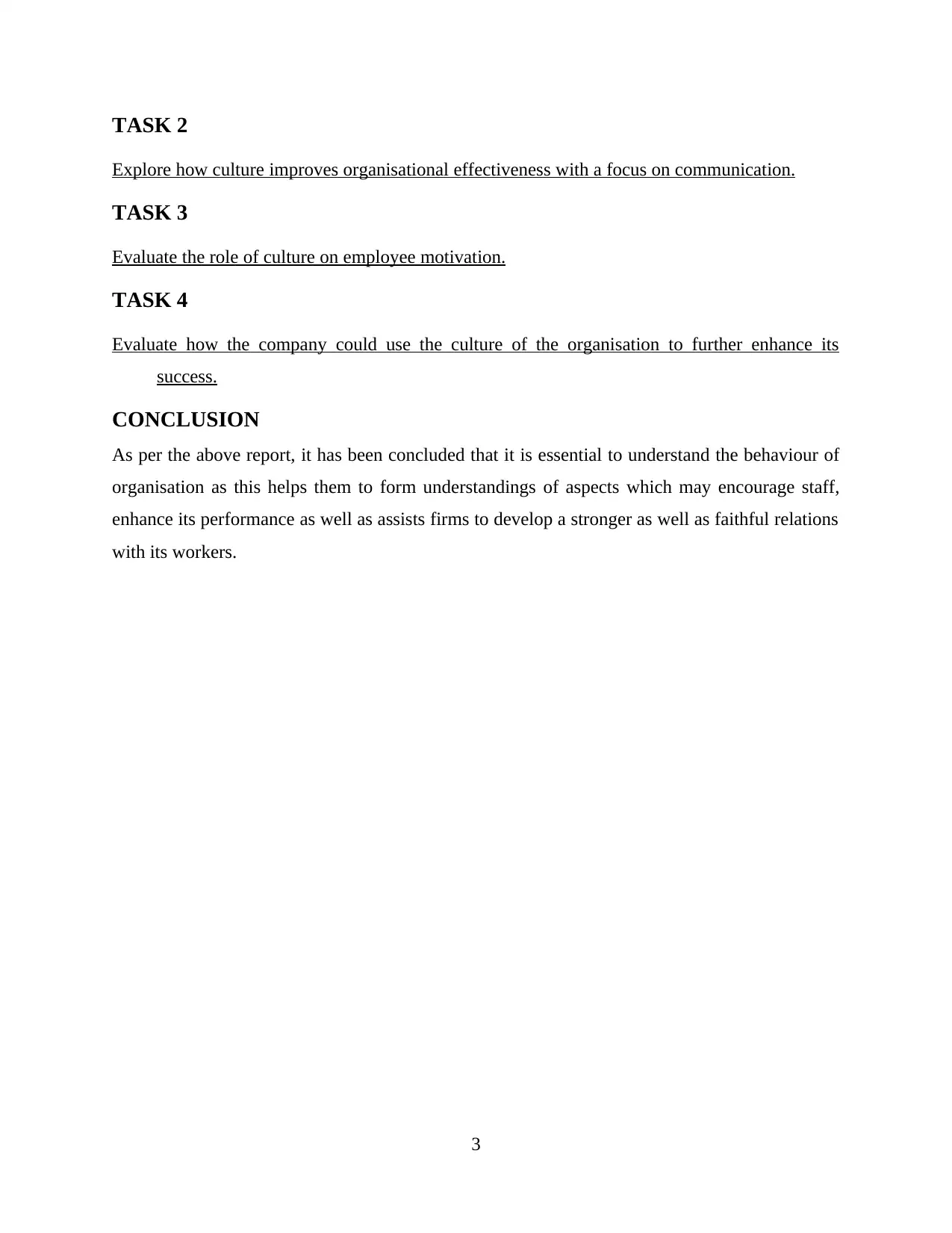
TASK 2
Explore how culture improves organisational effectiveness with a focus on communication.
TASK 3
Evaluate the role of culture on employee motivation.
TASK 4
Evaluate how the company could use the culture of the organisation to further enhance its
success.
CONCLUSION
As per the above report, it has been concluded that it is essential to understand the behaviour of
organisation as this helps them to form understandings of aspects which may encourage staff,
enhance its performance as well as assists firms to develop a stronger as well as faithful relations
with its workers.
3
Explore how culture improves organisational effectiveness with a focus on communication.
TASK 3
Evaluate the role of culture on employee motivation.
TASK 4
Evaluate how the company could use the culture of the organisation to further enhance its
success.
CONCLUSION
As per the above report, it has been concluded that it is essential to understand the behaviour of
organisation as this helps them to form understandings of aspects which may encourage staff,
enhance its performance as well as assists firms to develop a stronger as well as faithful relations
with its workers.
3
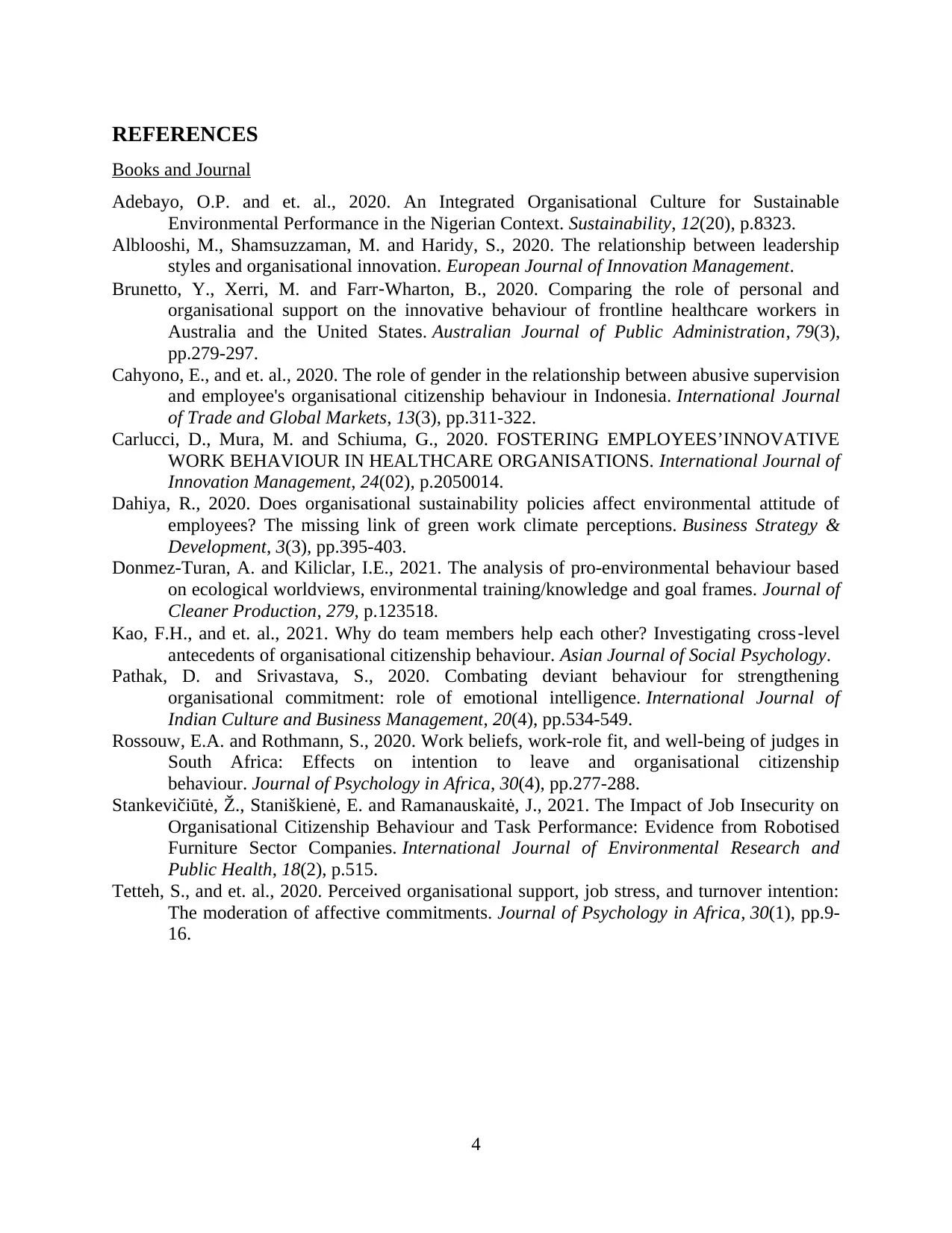
REFERENCES
Books and Journal
Adebayo, O.P. and et. al., 2020. An Integrated Organisational Culture for Sustainable
Environmental Performance in the Nigerian Context. Sustainability, 12(20), p.8323.
Alblooshi, M., Shamsuzzaman, M. and Haridy, S., 2020. The relationship between leadership
styles and organisational innovation. European Journal of Innovation Management.
Brunetto, Y., Xerri, M. and Farr‐Wharton, B., 2020. Comparing the role of personal and
organisational support on the innovative behaviour of frontline healthcare workers in
Australia and the United States. Australian Journal of Public Administration, 79(3),
pp.279-297.
Cahyono, E., and et. al., 2020. The role of gender in the relationship between abusive supervision
and employee's organisational citizenship behaviour in Indonesia. International Journal
of Trade and Global Markets, 13(3), pp.311-322.
Carlucci, D., Mura, M. and Schiuma, G., 2020. FOSTERING EMPLOYEES’INNOVATIVE
WORK BEHAVIOUR IN HEALTHCARE ORGANISATIONS. International Journal of
Innovation Management, 24(02), p.2050014.
Dahiya, R., 2020. Does organisational sustainability policies affect environmental attitude of
employees? The missing link of green work climate perceptions. Business Strategy &
Development, 3(3), pp.395-403.
Donmez-Turan, A. and Kiliclar, I.E., 2021. The analysis of pro-environmental behaviour based
on ecological worldviews, environmental training/knowledge and goal frames. Journal of
Cleaner Production, 279, p.123518.
Kao, F.H., and et. al., 2021. Why do team members help each other? Investigating cross‐level
antecedents of organisational citizenship behaviour. Asian Journal of Social Psychology.
Pathak, D. and Srivastava, S., 2020. Combating deviant behaviour for strengthening
organisational commitment: role of emotional intelligence. International Journal of
Indian Culture and Business Management, 20(4), pp.534-549.
Rossouw, E.A. and Rothmann, S., 2020. Work beliefs, work-role fit, and well-being of judges in
South Africa: Effects on intention to leave and organisational citizenship
behaviour. Journal of Psychology in Africa, 30(4), pp.277-288.
Stankevičiūtė, Ž., Staniškienė, E. and Ramanauskaitė, J., 2021. The Impact of Job Insecurity on
Organisational Citizenship Behaviour and Task Performance: Evidence from Robotised
Furniture Sector Companies. International Journal of Environmental Research and
Public Health, 18(2), p.515.
Tetteh, S., and et. al., 2020. Perceived organisational support, job stress, and turnover intention:
The moderation of affective commitments. Journal of Psychology in Africa, 30(1), pp.9-
16.
4
Books and Journal
Adebayo, O.P. and et. al., 2020. An Integrated Organisational Culture for Sustainable
Environmental Performance in the Nigerian Context. Sustainability, 12(20), p.8323.
Alblooshi, M., Shamsuzzaman, M. and Haridy, S., 2020. The relationship between leadership
styles and organisational innovation. European Journal of Innovation Management.
Brunetto, Y., Xerri, M. and Farr‐Wharton, B., 2020. Comparing the role of personal and
organisational support on the innovative behaviour of frontline healthcare workers in
Australia and the United States. Australian Journal of Public Administration, 79(3),
pp.279-297.
Cahyono, E., and et. al., 2020. The role of gender in the relationship between abusive supervision
and employee's organisational citizenship behaviour in Indonesia. International Journal
of Trade and Global Markets, 13(3), pp.311-322.
Carlucci, D., Mura, M. and Schiuma, G., 2020. FOSTERING EMPLOYEES’INNOVATIVE
WORK BEHAVIOUR IN HEALTHCARE ORGANISATIONS. International Journal of
Innovation Management, 24(02), p.2050014.
Dahiya, R., 2020. Does organisational sustainability policies affect environmental attitude of
employees? The missing link of green work climate perceptions. Business Strategy &
Development, 3(3), pp.395-403.
Donmez-Turan, A. and Kiliclar, I.E., 2021. The analysis of pro-environmental behaviour based
on ecological worldviews, environmental training/knowledge and goal frames. Journal of
Cleaner Production, 279, p.123518.
Kao, F.H., and et. al., 2021. Why do team members help each other? Investigating cross‐level
antecedents of organisational citizenship behaviour. Asian Journal of Social Psychology.
Pathak, D. and Srivastava, S., 2020. Combating deviant behaviour for strengthening
organisational commitment: role of emotional intelligence. International Journal of
Indian Culture and Business Management, 20(4), pp.534-549.
Rossouw, E.A. and Rothmann, S., 2020. Work beliefs, work-role fit, and well-being of judges in
South Africa: Effects on intention to leave and organisational citizenship
behaviour. Journal of Psychology in Africa, 30(4), pp.277-288.
Stankevičiūtė, Ž., Staniškienė, E. and Ramanauskaitė, J., 2021. The Impact of Job Insecurity on
Organisational Citizenship Behaviour and Task Performance: Evidence from Robotised
Furniture Sector Companies. International Journal of Environmental Research and
Public Health, 18(2), p.515.
Tetteh, S., and et. al., 2020. Perceived organisational support, job stress, and turnover intention:
The moderation of affective commitments. Journal of Psychology in Africa, 30(1), pp.9-
16.
4
⊘ This is a preview!⊘
Do you want full access?
Subscribe today to unlock all pages.

Trusted by 1+ million students worldwide
1 out of 6
Related Documents
Your All-in-One AI-Powered Toolkit for Academic Success.
+13062052269
info@desklib.com
Available 24*7 on WhatsApp / Email
![[object Object]](/_next/static/media/star-bottom.7253800d.svg)
Unlock your academic potential
Copyright © 2020–2025 A2Z Services. All Rights Reserved. Developed and managed by ZUCOL.





